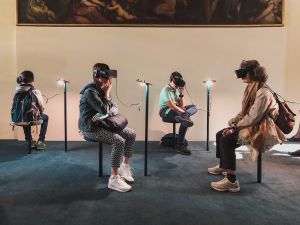Test Owner
Gekko part of Accenture
En juin 2020, Accenture complétait son acquisition de Gekko, entreprise française leader des services Amazon Web Services (AWS),dans la continuité de sa stratégie « Cloud First »
Gekko compte plus d’une centaine de professionnels formés aux technologies du cloud, de 100 certifications AWS et d’une relation forte avec AWS.
Accenture, avec ses 509 000 employés dans plus de 120 pays, est un des leaders mondiaux des services aux entreprises et administrations et s’appuie sur le plus grand réseau international de centres de technologie avancée et d’opérations intelligentes.
Cette acquisition a permis de renforcer la position de leader d’Accenture dans le domaine du Cloud et de l’IA, d’élargir la collaboration existante avec les fournisseurs clés du marché, au premier rang desquels l’écosystème de partenaires Amazon, Google et Microsoft et renforcer les services de migration vers le cloud pour soutenir les objectifs stratégiques d’Accenture AWS Business Group (AABG) en France, Belgique, Luxembourg et aux Pays-Bas.
Constamment à la recherche de nouveaux talents pour les rejoindre Gekko part of Accenture se concentre sur 4 domaines d'expertise : - Cloud Adoption : Design & architecture, migration, change management, hybridation / DirectConnect, formation. - Industrialisation DevOps : Infra-as-code / Patterns, Chaîne CI/CD,Forge, Build to Run. - CloudOps & FinOps : Run “Next Gen” (exploitation full automatisée), gouvernance financière et opérationnelle du Cloud, optimisation financière.
Source: Gekko – Part of Accenture https://newsroom.accenture.fr
Today, the company Framatome announced the completion of its purchase of Rolls Royce Civil Nuclear Instrumentation and Control (I&C). The deal which was first announced back in December 2020, will enlarges the industrial footprint of Framatome, and expands its global I&C systems development and deployment capabilities.
Framatome is an international leader in nuclear energy: the company is renowned for its reliability, its expertise and its performance in designs and installation of components, fuel, and instrumentation and control systems for nuclear power plants.
Rolls-Royce says the deal, for which it provides no financial details, contributes to the target it set last year of GBP2 billion in disposals. The I&C business had GBP74 million in revenue in 2020.
Through this transaction, more than 550 employees mainly located in France will be a part of the company. At the same time, Rolls-Royce Civil Nuclear’s products and technologies such as Spinline, Rodline and Hardline will be incorporated into Framatome’s I&C portfolio.
However, none of the group's employees based in the United Kingdom will be impacted by this transaction. Indeed, it does not include the civil nuclear activities of Rolls-Royce in the United Kingdom, nor those concerning the small modular reactors (SMR- Small Modular Reactor) which will still contribute to locally supplying low-carbon electricity.
Additionally, this purchase will allow new resources to the I&C in order to offer more reliable, low carbon nuclear energy production which is becoming a real issue nowadays.
Source: https://www.framatome.com
Almost every industry across the globe is still struggling to recover from the coronavirus pandemic’s effect on 2020 sales and the MedTech sector was not spread at all: indeed, the impact was far from even, given the diverse range of MedTech companies, from those that make heart valves to artificial hips and knees to robotics to point of care testing.
Despite these difficulties, The Midwest’s Largest Annual Design and Manufacturing Event took place last week between the 2 and 3 November. It included the latest insights and solutions spanning medtech, packaging, automation, plastics, and design.
OmniVision Technologies Inc. demonstrated its OVMed OH0FA image sensor and OAH0428 bridge chip for endoscopes and catheters during MD&M Minneapolis. The company states this new image sensor presents the highest available resolution for ENT, cardiac, arthro, OB-GYN, and utero-renal endoscopes. The OAH0428 bridge chip, compatible with 720x720 resolution, offers analog-to-digital conversion and flexibility for a variety of analog and digital inputs and outputs.
Ehsan Ayar, the medical product marketing manager at OmniVision, stated in a news release “ We have designed the OH0FA image sensor to offer the highest resolution at the best frame rate possible, with the flexibility to increase the frame rate at a lower resolution to cater to procedures with different requirements. Additionally, we have built in a high level of flexibility with the OAH0428 bridge chip.”
An other product presented during this event was “FlexSense” which is a wireless sensor technology. The company described this device as stretchable, compressible, and wearable, suiting it for applications in athletics, health, and wellness. They are made of a silicon-based material and conductive ink that can withstand use environments including heat, cold, and moisture.
Additionally, a new medical 3D printer the Core 5 Series Med XL – 385 created by B9Creations was shown during the event: The system is suitable for the design and production of medical devices, anatomical modelling, surgical tools, and more. Its particularity remains in the fact the company succeeded in realising a translucent companion resin called HD Clear. According to the company, the printed parts can be made fully transparent and appear glass-like.
Innovation today is the only solution for MedTech’s to navigate the sales environment through the pandemic.
This week, Facebook indicated its decision to foster 10,000 new jobs in the EU committed into building the Metaverse, which has became one of its big priorities.
But what is Metaverse?
Metaverse is defined by being " a virtual-reality space in which users can interact with a computer-generated environment and other users”
That means that unlike current VR, which is mostly limited to gaming, this virtual world would allow you to connect with all sorts of digital environments such as work, play, concerts, cinema trips - or just hanging out.
Even if its definition is still pretty indefinite, the incorporation of an avatar - a representation of yourself - as you use it is probably one of its main components.
An unexpectedly value?
Metaverse is suddenly becoming a main concern for investors and big tech firms, who don’t want to miss this promising opportunity, which might become “the future of the internet.”
With the constant advancements in VR gaming, the interests are rising as testify the involvement of Facebook
Indeed, while they were improving their Oculus headsets, making them more competitive on the market, they also kept developing VR apps for social hangouts and for the workplace, which will include connections with reality.
However, Facebook emphasised the fact it has the desire to collaborate; being aware than “the Metaverse "won't be built overnight by a single company". Consequently the firm has invested “ $50m (£36.3m) in funding non-profit groups to help build the Metaverse responsibly.
Nethertheless, as Facebook already know it, the Metaverse idea is still in an early stage, targeted by multiple tech giants, which will take another 10 to 15 years to come to an end.
Source: www.bbc.co.uk
UK faces shortage of workers
The impacts of Brexit and lockdown have combined to create the worst shortage of potential job candidates on record in the UK. As the country begins to open back up following months of intermittent lockdowns due to COVID-19, the economy has surged, creating many more new jobs which simply cannot be filled.
Due to Brexit, fewer EU workers have been able to get visas to work in Britain. Many of those who had been resident in the UK before Brexit had applications to remain indefinitely rejected due to insufficient salary, sub-par language skills, or other factors. EU workers have traditionally been more likely to be employed in lower-skilled jobs; around half of highly-educated workers born in the EU were employed in less skilled jobs as of 2019. As a result, recruiters working in these areas are struggling to fill a lot of the positions created by these departing workers.
As a result of COVID-19, many businesses have also had to fundamentally change their methods of operating, to better accommodate remote working and changes in the customer base. The completion of the government’s furlough scheme has also meant that many workers are returning to full-time work in markets that have changed immeasurably since the beginning of the pandemic, and so they need to be retrained in order to fit the updated demands of the job market.
Source: www.yahoo.com
The future of the aviation industry after COVID
Eighteen months of global lockdowns and ongoing border closures have devastated the aviation industry. In 2020, the industry’s revenues came to $328 billion, which was a 60% drop on the previous year, due to reduced numbers of flights and reduced demand to travel abroad. Even now, in late 2021, airlines are not carrying the numbers of passengers they were before the pandemic, and industry experts do not expect traffic to return to normal before 2024 at the earliest.
Leisure trips are expected to grow at the fastest rate out of any reason to travel. This was visible even a few months after the outbreak of the pandemic, when international travel was allowed between certain countries. Meanwhile, business trips were replaced to a great extent by remote work and Zoom meetings; previous crises such as 9/11 or the 2008 economic disaster have shown that business travel recovers extremely slowly in comparison to leisure trips.
The increased demands placed on airlines during and after the pandemic will also cause large increases in ticket prices. Many airlines have had to go into debt or borrow great deals of money in order to stay afloat, and must also now provide appropriate cleansing and/or PPE depending on the countries they are in; all of these factors mean that airlines will remunerate themselves by increasing their ticket prices.
Air freight was the main source of revenue for most airlines during COVID restrictions; while passenger flights had to be reduced, cargo flights could continue with some caveats. As a result, cargo yields increased by about 30% in the last year, and many airlines brought their cargo freighter fleets out of retirement. This trend is expected to continue, but the share of revenue generated by air freight will reduce as passenger flights return to their pre-pandemic rates.
Source: www.mckinsey.com
ASIC and FPGA are both types of microchips that can be used when designing an electronic product. An ASIC must be created according to a product’s specifications, as it is only programmed for one specific use and cannot be reprogrammed. An FPGA, in contract, is manufactured for general use and can be used for multiple functions; some are able to be reprogrammed infinite times, whereas others can only be changed once.
The primary difference between the two is that an ASIC chip is specifically purposed for one application, whereas an FPGA chip can be used and reprogrammed multiple times. As such, the decision as to which of the chips to use often depends on many factors such as the quantity of the intended production, the desired level of customisation, and budget considerations.
The uses of the two chips also vary. ASIC chips, as they can be programmed specifically for the aim of a product, have a wide range of applications. These are primarily in devices with no need to remove and reprogram the chip, for example smartphones and TVs. Essentially, there is no limit to the different things that an ASIC chip can be used for.
The requirements for a reprogrammable chip such as an FPGA are slightly more limited. An engineer might use an FPGA when designing the prototype of a product, but in production stage they might instead change this to an ASIC. FPGAs are also useful when it comes to applications that require ongoing developments, such as image processing in security.
Source: www.asicnorth.com
What is MS Dynamics AX Navision?
Among Microsoft’s many products and services is Dynamics AX, which is a piece of business software created by the company. Its aim is to aid businesses in managing their back-end operations, which are necessary to keep them running from day to day. These operations include businesses intelligence and warehouse management, as well as HR and manufacturing. The software was launched in 2003 with five products, and has only continued to expand since then. In 2016, Microsoft combined its CRM products with its ERP products to create one umbrella known as Dynamics 365.
This software is specifically aimed towards medium and large sized businesses, who often have more complex back-end operations. Although its versatility makes it suitable for plenty of different industries, in practice those that use it the most are within the retail, manufacturing, and distribution sectors. Currently AX Navision is in use in 118 countries using 24 different languages, and the total number of customers is over 20 000.
There are many reasons as to why the software would be attractive to a business. For one, it helps them to synchronise their operations across the company, enhance visibility for the organisation, improve their finances in terms of income and control, and achieve compliance. This helps to boost productivity and, in turn, profits.
Source: www.nigelfrank.com
What is AWS?
AWS stands for Amazon Web Services – essentially, it is an Amazon product that provides cloud computing platforms to customers ranging from individuals right up to national governments on a pay-as-you-go basis. It comprises over 200 products in total which cover all of the computing needs a client might have, from machine learning and developer tools to simple computing, storage, and networking. One key feature of the service is that it offers virtual computers which can be accessed at any time via the Internet; these tend to resemble a real computer in that they have CPU/GPUs, RAM memory, and SSD storage.
The system markets itself as being a relatively cheap and easy way to achieve large-scale computer processing, with its pay-as-you-go style helping to control the price paid by the customer. Subscribers can choose from a variety of services within AWS, depending on the level of security and the specific hardware and operating systems they require. In terms of security, AWS offers coverage all subscribers; in North America alone, there are six different locations from which the service operates.
As of 2017, AWS owned 33% of all cloud, which put it far ahead of its nearest competitors, Microsoft Azure and Google Cloud, which owned 18% and 9% respectively. The service was founded in 2002 in order to move Amazon towards a more customer-facing approach and to open their platform to any developers; the huge interest taken in it right from its inception meant that the company has since developed over 200 products. Notable customers include Netflix and Obama’s presidential campaign (2012). The huge growth that AWS has seen (32% yearly growth was reported in 2021) only looks set to continue.
Source: www.wikipedia.com
What is PTC Windchill?
PTC Windchill is a family of PLM software offered by PTC. PLM is the process of managing the lifecycle of a product, that is, of managing it right from the design stage through to distribution and disposal. Founded in 1985 in Massachusetts, PTC initially aimed to develop CAD modelling software, before branching out to other forms of technology such as augmented reality and collaboration software. In 1998, this expansion involved the creation of Windchill, and in 2004, the software was adapted to become simpler and aimed at small and medium sized businesses. The company is global, employing workers in thirty countries, and is worth over 1b.
The first edition of Windchill (version 4.0) was released in 1999, and since then there have been new releases almost every year, up to the current version (version 11.2.1.0), which was released in December 2019. Its implementation, although it can run on just one server, commonly uses three tiers – Client, Application, and Database.
Windchill capabilities are taught in IT/programming degrees at many universities, which has enabled it to become a globally used software. Its user base also ranges from individuals to large corporations, and the ease of scaling its software up or down to suit this has also aided its growth. The majority of its customers work in fields such as Automotive, Aerospace/Defence, and Industrial Products.
The products created by Windchill range from Product Analytics (this service is provided by Windchill Compliance, Windchill Materials & Substances, Windchill Cost, and Windchill LCA) to Utilities and Collaboration, both of which have multiple products to provide the service.
Source: www.wikipedia.com














